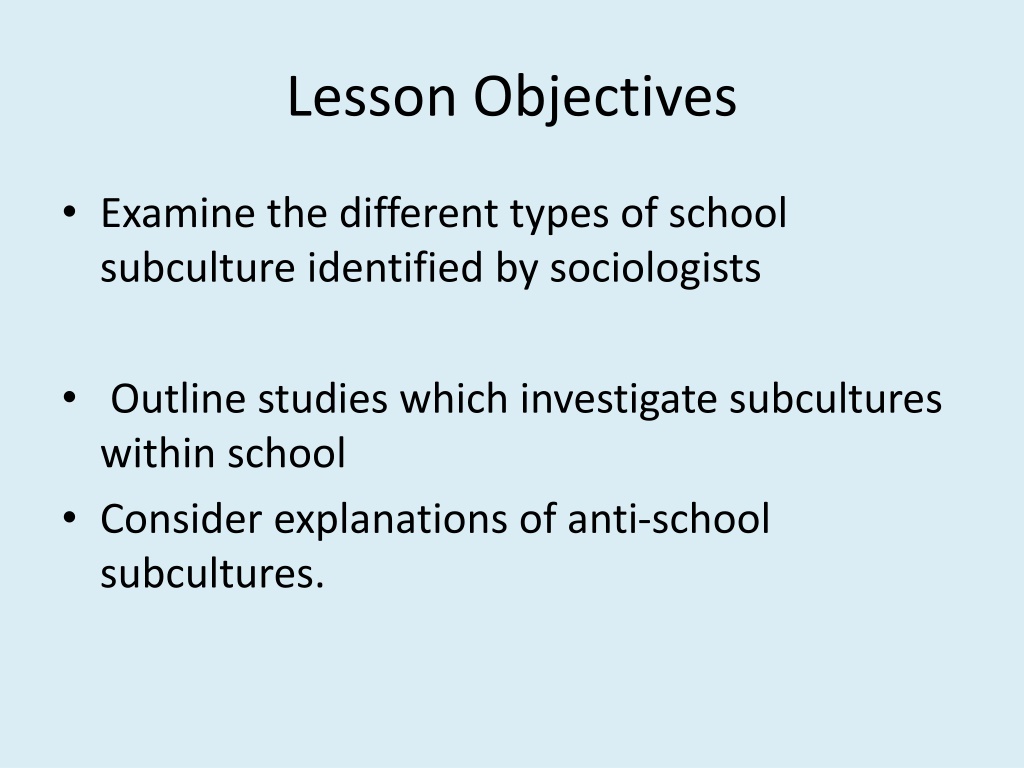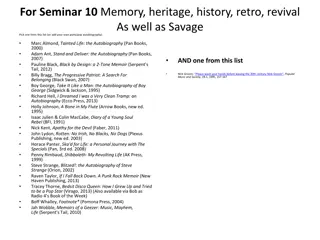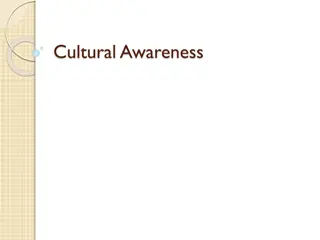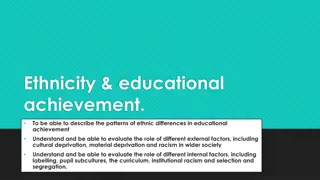Exploring School Subcultures and Their Impact
This information delves into the various types of school subcultures, including anti-school subcultures, and examines studies on subcultures within schools. It discusses the behaviors, attitudes, and statuses associated with different school subcultures and highlights the impact of these subcultures on inequalities, class differences, and achievement gaps. Various sociologists' research, such as David Hargreaves and Paul Willis, provide insights into the formation and dynamics of school subcultures, challenging traditional views on shared values in schools.
Download Presentation

Please find below an Image/Link to download the presentation.
The content on the website is provided AS IS for your information and personal use only. It may not be sold, licensed, or shared on other websites without obtaining consent from the author. Download presentation by click this link. If you encounter any issues during the download, it is possible that the publisher has removed the file from their server.
E N D
Presentation Transcript
Lesson Objectives Examine the different types of school subculture identified by sociologists Outline studies which investigate subcultures within school Consider explanations of anti-school subcultures.
Anti-school subcultures 1. What will there attitude of school be? 2. What set would they be in? 3. How would they behave in school? 4. What would their status be in school?
Role play time.... You have 3 minutes to come up with a sketch which you think depicts a pro-social or anti-social school subculture
Anti-social subculture Low streams Working class Failure= Low self esteem- school has undermined them, reinforcing inferior status
So what impact do subcultures have within school? Creates inequalities Class differences Achievement differences Self fulfilling prophecy
Anti-social subculture Inverting school values of hard work, obedience and punctuality sabotage the system Form anti-social subculture to gain status
Pro-school subculture High streamed Middle class High status- successful Committed to values of the school Asian and Indian minorities
David Hargreaves (1967) Interviewed boys in secondary modern schools Subculture formed due to triple failures= failing 11+ Low streams Labelled worthless louts Found high status went to those who flouted the school rules!
AO3 critique Functionalists argue that school helps to establish shared culture and shared values Hargreaves suggests that this is incorrect. His research suggests processes within school create sub-cultures.
Paul Willis (1977) Participant observation in comprehensive in small industrial town in West Midlands Detailed ethnographic study of working class sub-culture of 12 lads in school Concluded that subculture was a deliberate resistance to capitalist system of oppression . They chose to be anti-school which sealed their fate as working-class labourers.
AO3 Critique How can we criticise Willis study? Is this study still relevant today? In 1977 lads went straight into labouring jobs. These are not available today. However Archer and Yamashati (2003) found laddish behaviour still strong in year 10 in London Comprehensive. They valued bad boy image and felt education was soft Do all working class kids fail? What about working class girls?
Girl sub-cultures Shain (2003) Asian girls using interviews she identified four groups. Asian gang girls resisted racism anti-school Survivors conformed and ignored racism Rebels pro-school rebelled against parents Jackson (2006) Ladettes White working class and masculine norms e.g disruptive, rude, smoking, swearing, open sexuality.
AO3 Critique This shows that not all girls are conforming However not all working class girls are anti- school. The rise of masculine behaviour in girls could be linked to rise of feminism. Female violence and crime is also rising!
Ethnicity and sub-cultures Tony Sewell (2000) studied African-Caribbean subcultures. Not all were anti-school Conformists Pro-school Innovators Pro-education but anti-school. Retreatists non confrontational but anti- school Rebels formed a posse anti-school.
http://newsimg.bbc.co.uk/media/images/41758000/jpg/_41758898_tony_sewell203.jpghttp://newsimg.bbc.co.uk/media/images/41758000/jpg/_41758898_tony_sewell203.jpg AO3 critique Is it that schools are institutionally racist or is it related to African-Caribbean culture? Tony Sewell said racism is not the main issue. He identified problem as black culture of anti-school masculinity Lone parenthood in black families leading to gang cultures and peer pressure to be masculine.
Explanations of anti-school subcultures. Collective response to teacher/school labelling- streaming/11+ etc Hargreaves (1967) Collective resistance to inequalities of capitalism. Willis (1977) Rise of Feminism- crisis of masculinity (Archer and Yamashati (2003) Jackson (2006)) Culture differences and/or racism in schools Sewell (2000).
Objectives: 1. Identify areas for improvement in essay writing skills. 2. Set appropriate individual targets to apply to an exam answer. 3. Consider further improvements.
Identify your main areas for improvement in your essays Mark statements on your handout with:- Lovin it It s OK Needs attention Finally pick one which you will aim to improve on today.
Outline and Explain reasons why anti-school sub-cultures develop.(20) Intro Shared culture (Functionalism) OR Sub-cultures (Inequality, Hargreaves). Not all students join sub- cultures and not all sub-cultures are anti-school. P. Collective response to teacher labelling & self-fulfilling E. Hargreaves suggests sub-cultures response to triple failure and streaming A/E. Suggests schools are to blame. However students can reject label (Shain s Survivors. P. Social Class Marxism and resistance to exploitation E. Paul Willis Learning to labour A/E. Suggests sub-cultures are collective response to inequalities in capitalism. However not all working class students end up in low-paid jobs. P. Gender - Crisis of Masculinity E. Archer and Yamashati suggest boys feel education is feminised. Wilkinsons genderquake , Jackson identified growing ladette culture. A/E. Suggests boys view education as effeminate so re-create masculine culture as anti-education. However middle class boys ok. P. Ethnicity Cultural differences E. Tony Sewell , African Caribbean street culture is anti-school, black single mothers (Hackney) A/E. Suggests reason is outside of school. However could be cultural clash with teachers and some were conformists. Indian and Chinese have different culture but are pro-school. Conclusion Brief summary of reasons. Anti-school subcultures develop for reasons related to labelling, class, ethnicity and gender. However not all students who are working class or male are anti-school. Also not all ethnic minorities are anti-school.
Outline and Explain reasons why anti-school sub-cultures develop.(20) Intro Shared culture (Functionalism) OR Sub-cultures (Inequality, Hargreaves). Not all students join sub-cultures and not all sub-cultures are anti-school. P. Collective response to teacher labelling & self-fulfilling E. Becker, Rosenthal and Jacobson, Cicourel and Kitsuse (streaming) A/E. Suggests schools are to blame. However students can reject label (Mirza) P. Social Class Marxism and resistance to exploitation E. Paul Willis Learning to labour A/E. Suggests sub-cultures are collective response to inequalities in capitalism. However not all working class students end up in low-paid jobs. P. Gender - Crisis of Masculinity E. Wilkinsons genderquake , Faludi and Bly, Laddish culture. A/E. Suggests boys view education as effeminate so re-create masculine culture as anti-education. However middle class boys ok. P. Ethnicity Cultural differences E. Tony Sewell , African Caribbean street culture is anti-school, black single mothers (Hackney) A/E. Suggests reason is outside of school. However could be cultural clash with teachers (lack cultural capital) Indian and Chinese(Modood) Conclusion Brief summary of reasons.
Peer Assess Write a comment about how well they met their target for today and any other areas of improvement. Award AO1 6 AO2 4 AO3 5 12 = A 11 = B 10 = C 8 = D 7 = E























